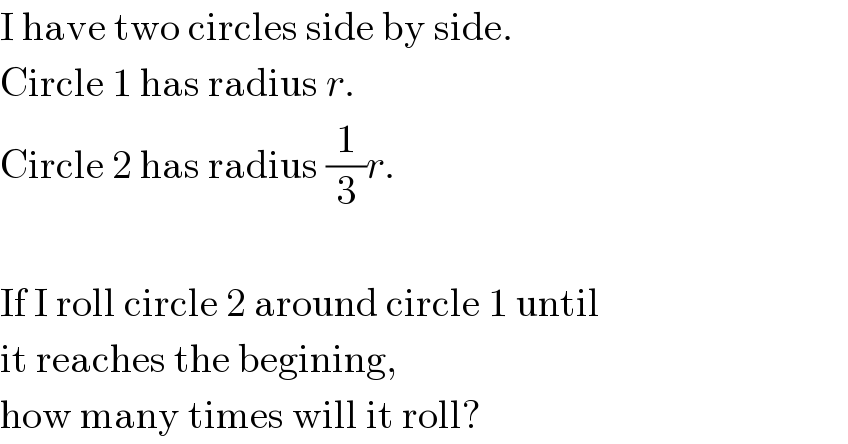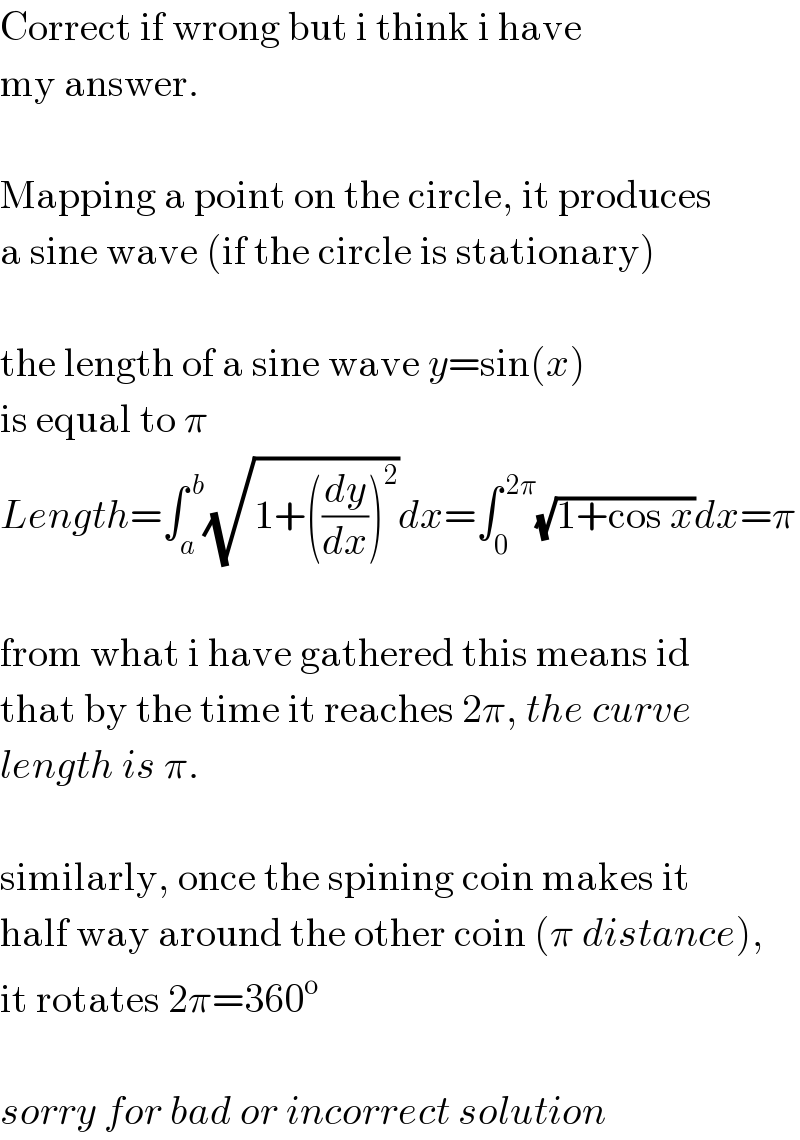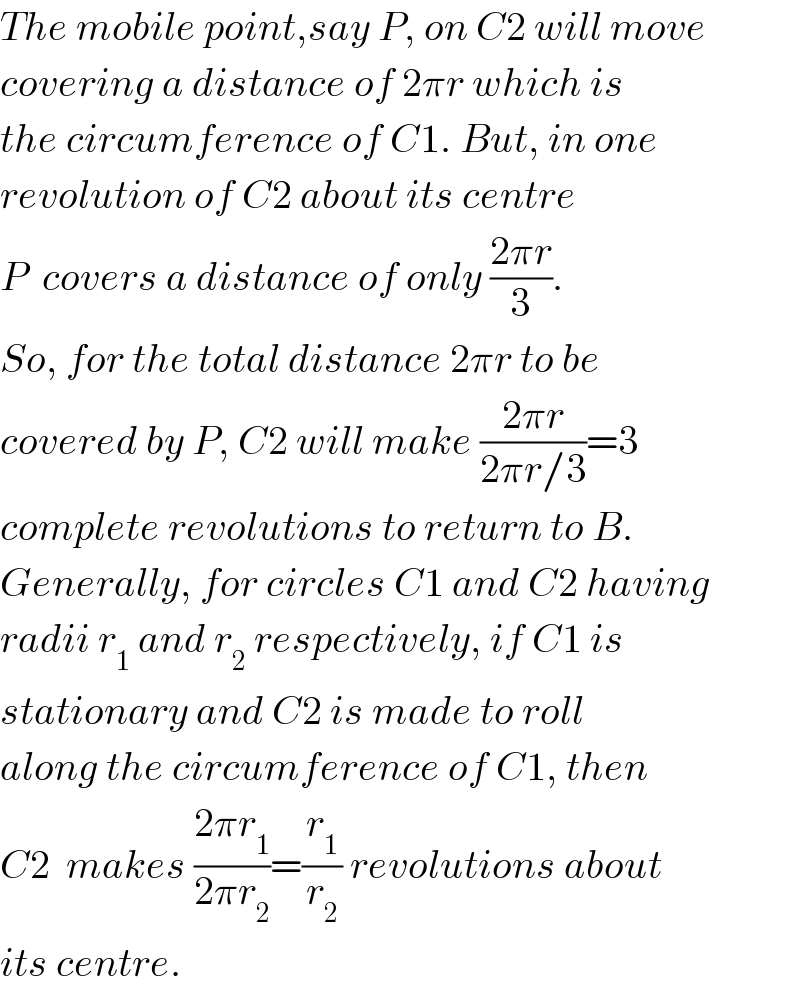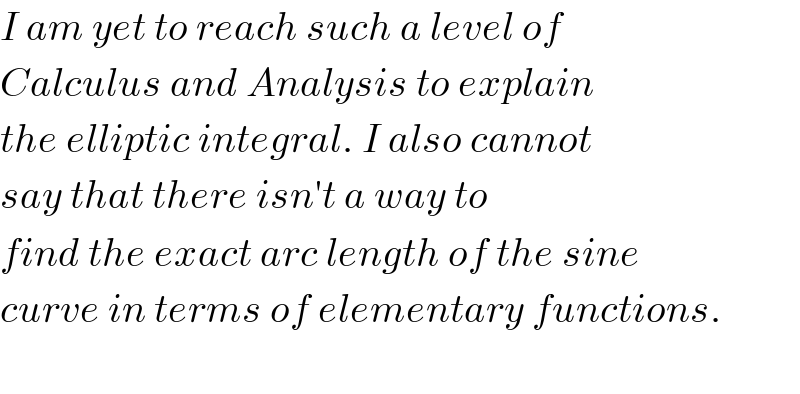
Question Number 5546 by FilupSmith last updated on 19/May/16

$$\mathrm{I}\:\mathrm{have}\:\mathrm{two}\:\mathrm{circles}\:\mathrm{side}\:\mathrm{by}\:\mathrm{side}. \\ $$$$\mathrm{Circle}\:\mathrm{1}\:\mathrm{has}\:\mathrm{radius}\:{r}. \\ $$$$\mathrm{Circle}\:\mathrm{2}\:\mathrm{has}\:\mathrm{radius}\:\frac{\mathrm{1}}{\mathrm{3}}{r}. \\ $$$$ \\ $$$$\mathrm{If}\:\mathrm{I}\:\mathrm{roll}\:\mathrm{circle}\:\mathrm{2}\:\mathrm{around}\:\mathrm{circle}\:\mathrm{1}\:\mathrm{until} \\ $$$$\mathrm{it}\:\mathrm{reaches}\:\mathrm{the}\:\mathrm{begining}, \\ $$$$\mathrm{how}\:\mathrm{many}\:\mathrm{times}\:\mathrm{will}\:\mathrm{it}\:\mathrm{roll}? \\ $$
Commented by FilupSmith last updated on 19/May/16

$$\mathrm{Correct}\:\mathrm{if}\:\mathrm{wrong}\:\mathrm{but}\:\mathrm{i}\:\mathrm{think}\:\mathrm{i}\:\mathrm{have} \\ $$$$\mathrm{my}\:\mathrm{answer}. \\ $$$$ \\ $$$$\mathrm{Mapping}\:\mathrm{a}\:\mathrm{point}\:\mathrm{on}\:\mathrm{the}\:\mathrm{circle},\:\mathrm{it}\:\mathrm{produces} \\ $$$$\mathrm{a}\:\mathrm{sine}\:\mathrm{wave}\:\left(\mathrm{if}\:\mathrm{the}\:\mathrm{circle}\:\mathrm{is}\:\mathrm{stationary}\right) \\ $$$$ \\ $$$$\mathrm{the}\:\mathrm{length}\:\mathrm{of}\:\mathrm{a}\:\mathrm{sine}\:\mathrm{wave}\:{y}=\mathrm{sin}\left({x}\right) \\ $$$$\mathrm{is}\:\mathrm{equal}\:\mathrm{to}\:\pi \\ $$$${Length}=\int_{{a}} ^{\:{b}} \sqrt{\mathrm{1}+\left(\frac{{dy}}{{dx}}\right)^{\mathrm{2}} }{dx}=\int_{\mathrm{0}} ^{\:\mathrm{2}\pi} \sqrt{\mathrm{1}+\mathrm{cos}\:{x}}{dx}=\pi \\ $$$$ \\ $$$$\mathrm{from}\:\mathrm{what}\:\mathrm{i}\:\mathrm{have}\:\mathrm{gathered}\:\mathrm{this}\:\mathrm{means}\:\mathrm{id} \\ $$$$\mathrm{that}\:\mathrm{by}\:\mathrm{the}\:\mathrm{time}\:\mathrm{it}\:\mathrm{reaches}\:\mathrm{2}\pi,\:{the}\:{curve} \\ $$$${length}\:{is}\:\pi. \\ $$$$ \\ $$$$\mathrm{similarly},\:\mathrm{once}\:\mathrm{the}\:\mathrm{spining}\:\mathrm{coin}\:\mathrm{makes}\:\mathrm{it} \\ $$$$\mathrm{half}\:\mathrm{way}\:\mathrm{around}\:\mathrm{the}\:\mathrm{other}\:\mathrm{coin}\:\left(\pi\:{distance}\right), \\ $$$$\mathrm{it}\:\mathrm{rotates}\:\mathrm{2}\pi=\mathrm{360}^{\mathrm{o}} \\ $$$$ \\ $$$${sorry}\:{for}\:{bad}\:{or}\:{incorrect}\:{solution} \\ $$
Commented by Yozzii last updated on 20/May/16
![The integral expression for the arc length of the sine curve cannot be expressed in terms of elementary functions. This is because no such result can be the antiderivative of (√(1+cos^2 x)). For the closed interval [0,2π] the arc length ∫_0 ^(2π) (√(1+cos^2 x))dx≈7.6≠π.](Q5555.png)
$${The}\:{integral}\:{expression}\:{for}\:{the}\:{arc} \\ $$$${length}\:{of}\:{the}\:{sine}\:{curve}\:{cannot}\:{be} \\ $$$${expressed}\:{in}\:{terms}\:{of}\:{elementary}\:{functions}. \\ $$$${This}\:{is}\:{because}\:{no}\:{such}\:{result}\:{can}\:{be} \\ $$$$\:{the}\:{antiderivative}\:{of}\:\sqrt{\mathrm{1}+{cos}^{\mathrm{2}} {x}}. \\ $$$${For}\:{the}\:{closed}\:{interval}\:\left[\mathrm{0},\mathrm{2}\pi\right]\:{the}\:{arc} \\ $$$${length}\:\int_{\mathrm{0}} ^{\mathrm{2}\pi} \sqrt{\mathrm{1}+{cos}^{\mathrm{2}} {x}}{dx}\approx\mathrm{7}.\mathrm{6}\neq\pi. \\ $$
Commented by FilupSmith last updated on 19/May/16

Commented by Yozzii last updated on 19/May/16

$$\mathrm{2}\pi{r}×\frac{\mathrm{1}}{\mathrm{2}\pi{r}/\mathrm{3}}=\mathrm{3}\:{times} \\ $$$$ \\ $$
Commented by Yozzii last updated on 19/May/16

$${The}\:{mobile}\:{point},{say}\:{P},\:{on}\:{C}\mathrm{2}\:{will}\:{move} \\ $$$${covering}\:{a}\:{distance}\:{of}\:\mathrm{2}\pi{r}\:{which}\:{is} \\ $$$${the}\:{circumference}\:{of}\:{C}\mathrm{1}.\:{But},\:{in}\:{one} \\ $$$${revolution}\:{of}\:{C}\mathrm{2}\:{about}\:{its}\:{centre}\: \\ $$$${P}\:\:{covers}\:{a}\:{distance}\:{of}\:{only}\:\frac{\mathrm{2}\pi{r}}{\mathrm{3}}. \\ $$$${So},\:{for}\:{the}\:{total}\:{distance}\:\mathrm{2}\pi{r}\:{to}\:{be} \\ $$$${covered}\:{by}\:{P},\:{C}\mathrm{2}\:{will}\:{make}\:\frac{\mathrm{2}\pi{r}}{\mathrm{2}\pi{r}/\mathrm{3}}=\mathrm{3} \\ $$$${complete}\:{revolutions}\:{to}\:{return}\:{to}\:{B}. \\ $$$${Generally},\:{for}\:{circles}\:{C}\mathrm{1}\:{and}\:{C}\mathrm{2}\:{having} \\ $$$${radii}\:{r}_{\mathrm{1}} \:{and}\:{r}_{\mathrm{2}} \:{respectively},\:{if}\:{C}\mathrm{1}\:{is} \\ $$$${stationary}\:{and}\:{C}\mathrm{2}\:{is}\:{made}\:{to}\:{roll} \\ $$$${along}\:{the}\:{circumference}\:{of}\:{C}\mathrm{1},\:{then} \\ $$$${C}\mathrm{2}\:\:{makes}\:\frac{\mathrm{2}\pi{r}_{\mathrm{1}} }{\mathrm{2}\pi{r}_{\mathrm{2}} }=\frac{{r}_{\mathrm{1}} }{{r}_{\mathrm{2}} }\:{revolutions}\:{about} \\ $$$${its}\:{centre}. \\ $$
Commented by FilupSmith last updated on 19/May/16

$$\mathrm{I}\:\mathrm{thought}\:\mathrm{so},\:\mathrm{too}.\:\mathrm{What}\:\mathrm{I}\:\mathrm{found}\:\mathrm{Is}\:\mathrm{that} \\ $$$$\mathrm{if}\:\mathrm{i}\:\mathrm{have}\:\mathrm{two}\:\mathrm{identical}\:\mathrm{coins},\:\mathrm{coin}\:\mathrm{1}\:\mathrm{will} \\ $$$$\mathrm{rotate}\:\mathrm{TWICE}\:\mathrm{as}\:\mathrm{if}\:\mathrm{does}\:\mathrm{a}\:\mathrm{full}\:\mathrm{cycle}. \\ $$$$\mathrm{I}\:\mathrm{dont}\:\mathrm{know}\:\mathrm{why} \\ $$
Commented by Yozzii last updated on 19/May/16

$${So}\:{the}\:{mobile}\:{coin}\:{revolved}\:{through} \\ $$$$\mathrm{720}°\:{while}\:{both}\:{coins}\:{are}\:{identical}? \\ $$
Commented by FilupSmith last updated on 19/May/16

$$\mathrm{correct}!\:\mathrm{try}\:\mathrm{it}\:\mathrm{yourself}! \\ $$
Commented by FilupSmith last updated on 19/May/16

$$\mathrm{I}\:\mathrm{can}'\mathrm{t}\:\mathrm{understand}\:\mathrm{why}\:\mathrm{this}\:\mathrm{happenes}! \\ $$
Commented by FilupSmith last updated on 20/May/16

$$\mathrm{Oh},\:\mathrm{i}\:\mathrm{see},\:\mathrm{i}\:\mathrm{reaslised}\:\mathrm{my}\:\mathrm{mistake}. \\ $$$$\mathrm{So}\:\mathrm{is}\:\mathrm{there}\:\mathrm{a}\:\mathrm{way}\:\mathrm{to}\:\mathrm{determine}\:\mathrm{its}\:\mathrm{length}? \\ $$
Commented by Yozzii last updated on 20/May/16

Commented by Yozzii last updated on 20/May/16

Commented by Yozzii last updated on 20/May/16

$${I}\:{am}\:{yet}\:{to}\:{reach}\:{such}\:{a}\:{level}\:{of} \\ $$$${Calculus}\:{and}\:{Analysis}\:{to}\:{explain} \\ $$$${the}\:{elliptic}\:{integral}.\:{I}\:{also}\:{cannot} \\ $$$${say}\:{that}\:{there}\:{isn}'{t}\:{a}\:{way}\:{to} \\ $$$${find}\:{the}\:{exact}\:{arc}\:{length}\:{of}\:{the}\:{sine} \\ $$$${curve}\:{in}\:{terms}\:{of}\:{elementary}\:{functions}. \\ $$$$ \\ $$
